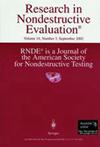基于声发射技术的管道故障预测神经网络系统
IF 1
4区 材料科学
Q3 MATERIALS SCIENCE, CHARACTERIZATION & TESTING
引用次数: 3
摘要
评估管道在压力下裂纹扩展的失效风险问题具有很大的实际意义,可以用声发射技术来解决。可以训练人工神经网络,根据传播阶段对裂纹产生的声发射进行分类,这样的分类允许评估维持系统运行的风险。为了训练网络,人类专家必须通过检查之前的静水试验结果来估计任意两个连续阶段之间的过渡时间,这种过渡时间的确定具有高度的主观性和不确定性,影响网络的分类性能。在本文中,我们提出了一种不依赖于人的方法来估计过渡时间,并成功地应用于两个流体静力试验的数据。在一个2米长的管道测试中,该方法显示出98%的正确分类率,比人工确定过渡时间的结果提高了8%。对于40米长的管道,在与工业应用相媲美的实验条件下,该方法的正确分类率为91%。提出的方法为裂缝状态评估提供了一个完全自动化的框架。本文章由计算机程序翻译,如有差异,请以英文原文为准。
A Neural Network System for Fault Prediction in Pipelines by Acoustic Emission Techniques
ABSTRACT The problem of evaluating the risk of failure associated with the propagation of a crack in a pipe under pressure has great practical relevance, and it may be tackled with acoustic-emission techniques. Artificial neural networks may be trained to classify the acoustic emissions generated by the crack according to the phase of propagation, and such a classification permits to evaluate the risk of mantaining a system in operation. In order to train the network, a human specialist has to estimate the transition times between any two consecutive phases by inspecting the results of a previous hydrostatic test, and such determination of the transition times has a high degree of subjectivity and uncertainty, affecting the classification performance of the network. In this paper, we propose a human-independent method for the estimation of the transition times, and we show successful applications to the data from two hydrostatic tests. For a test on a 2 m-long pipe, the method exhibited 98% of correct-classification rate, an improvement of 8% over results obtained with human-determined transition times. For a 40 m-long pipe, under experimental conditions comparable to those found in industrial applications, the method exhibited 91% of correct-classification rate. The proposed method provides a fully automated framework for the evaluation of the state of a crack.
求助全文
通过发布文献求助,成功后即可免费获取论文全文。
去求助
来源期刊

Research in Nondestructive Evaluation
工程技术-材料科学:表征与测试
CiteScore
2.30
自引率
0.00%
发文量
14
审稿时长
>12 weeks
期刊介绍:
Research in Nondestructive Evaluation® is the archival research journal of the American Society for Nondestructive Testing, Inc. RNDE® contains the results of original research in all areas of nondestructive evaluation (NDE). The journal covers experimental and theoretical investigations dealing with the scientific and engineering bases of NDE, its measurement and methodology, and a wide range of applications to materials and structures that relate to the entire life cycle, from manufacture to use and retirement.
Illustrative topics include advances in the underlying science of acoustic, thermal, electrical, magnetic, optical and ionizing radiation techniques and their applications to NDE problems. These problems include the nondestructive characterization of a wide variety of material properties and their degradation in service, nonintrusive sensors for monitoring manufacturing and materials processes, new techniques and combinations of techniques for detecting and characterizing hidden discontinuities and distributed damage in materials, standardization concepts and quantitative approaches for advanced NDE techniques, and long-term continuous monitoring of structures and assemblies. Of particular interest is research which elucidates how to evaluate the effects of imperfect material condition, as quantified by nondestructive measurement, on the functional performance.
 求助内容:
求助内容: 应助结果提醒方式:
应助结果提醒方式:


